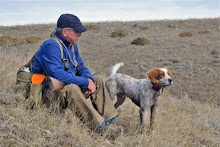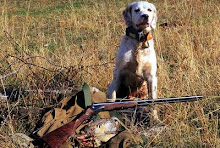Many people seem to have the idea that a field trial is a sort of greyhound race, and that trial bred dogs are useless to the hunter who walks behind his dog. This view has been promulgated by the many outdoor scribes who are long on opinions and short on actual experience. People read their words and believe and repeat them. It becomes 'fact' because everyone 'knows' it is true.
Other folks are skeptical that field trialing achieves the goal of improving the breeds of bird dogs.
But are these common perceptions really based in fact? Let us consider for a few minutes what qualities the IDEAL bird dog might have...
1. Endurance - a bird dog should be able to hunt at a good clip for a reasonable amount of time. My average hunt for birds in the West is between four and seven hours. I don't usually have the priviledge of looping back to my truck to exchange dogs, so I need a dog that can go the distance. I doubt that there are many hunting venues that ask more in terms of endurance than a day of chukar hunting in the river canyons of the Northwest. For this reason, I have put endurance first on the list. It may be less important to you.
2. Nose - without the physical ability to detect birds, a dog is decoration at best.
3. Intelligence – a dog must develop ‘bird sense’ by this I mean the ability to learn and retain the skills required to efficiently search out birds and to handle the birds so that the hunter is allowed the best opportunity for a shot. This requires some intelligence in the dog.
4. Ground application - the ideal dog is effective at hunting the available terrain and cover by intelligent application and must have the physical ability to get this done in all types of terrain in any weather that the owner may want to hunt or trial in. The dog needs to look at the terrain and cover and set off to search the high probability areas for birds. He should be swift, and not potter around every clump of cover.
5. Biddability - I am not a professional trainer. Like most amateurs, I want a dog that has a lot of natural ability AND that takes training quickly and retains it.
6. Handle - a dog that wants to be with its owner and is naturally inclined to please that owner will learn to hunt co-operatively and happily. It will be easy to teach, and eager to go about the business of finding birds for its owner. It seems that some dogs handle to the front and co-operate naturally.
7.. Temperment - My dogs, and I am sure many of yours, live with me year around, and are my constant companions. I want them to be calm and mannerly around me, my family, strangers, and other dogs - especially when hunting or trialing.
8. Style - as long as I am asking for all the attributes above, why not ask for a dog that looks great running and on its birds? Because we have to look at them, we may as well like what we see.
I think that most hunters who love dogs would like to have dogs with the appropriate mix of the qualities above. And it is no big leap to understand that field trialers seek the same qualities in the dogs they trial - and in many cases hunt behind. A trialer may value some of these attributes above others, depending on the venue he trails in, but they do want them all, and they judge dogs based in large part upon these attributes. Trialers, judges and breeders are all looking for "the whole package". This is true whether the trailer is running foot handled cover dogs, walking Shooting Dogs, or horseback handled Shooting Dogs and All-Age dogs. The ultimate goal of field trialing is to breed and demonstrate dogs with these qualities. While perfection is seldom, if ever, attained, it can be approached.
 I don't like 'tailgate photos' of a row of dead birds and grinning hunters. Seems like a missed opportunity to record a bagged bird some better way. I shot this photo about a dozen years ago, and like the composition with the frost colored leaves. Nikon F2AS - Fujichrome Velvia
I don't like 'tailgate photos' of a row of dead birds and grinning hunters. Seems like a missed opportunity to record a bagged bird some better way. I shot this photo about a dozen years ago, and like the composition with the frost colored leaves. Nikon F2AS - Fujichrome Velvia
















